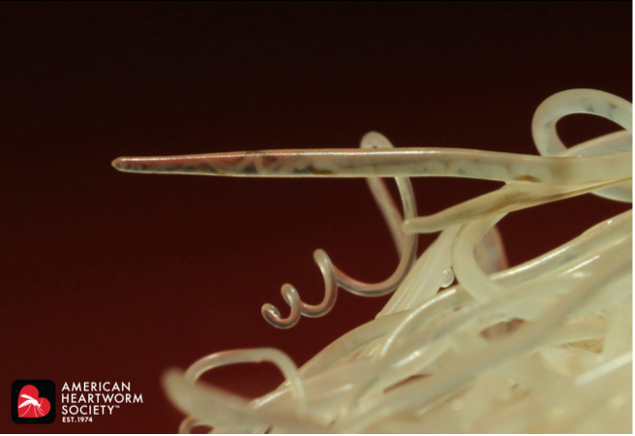Heartworm Disease in Dogs: Symptoms, Causes and Treatment
knape/iStock / Getty Images Plus via Getty Images
What Is Heartworm Disease in Dogs?
Heartworm disease in dogs is caused by the parasite Dirofilaria immitis. It causes heartworm disease not only in dogs, but also in cats, ferrets, and other mammals.
Heartworm is a large worm, reaching up to a foot or more in length. As it completes its life cycle—which takes about six to seven months—it ends up in an animal’s heart and pulmonary vessels, where it can live for several years.

As the heart becomes clogged with worms, there’s less blood it can push out to the rest of the body, and heart failure can result.
Symptoms of Heartworm Disease in Dogs
Severity of heartworm disease in dogs will be related to the symptoms present. Symptoms of heartworm in dogs are related to the organs affected—the heart and lungs.
Symptoms often include:
Some dogs may show weight loss, difficulty breathing, and even excessive panting. If left untreated, dogs may go on to experience right-sided heart failure and ascites.
Causes of Heartworm Disease in Dogs
Mosquitoes serve as the primary vector (carrier) for transmission of heartworm in dogs—dogs can’t spread heartworm to each other.
As mosquitoes bite and take blood from an infected host (such as another dog, fox, wolf, or coyote), they ingest circulating microfilariae, or young immature heartworms. Inside the mosquito, the microfilariae undergo three stages of larval development (larval stages include L1, L2, and L3).
When the same mosquito bites a dog, the L3 is deposited onto the dog’s skin, and it then migrates into the dog’s body and develops into L4.
As an L5, it migrates throughout a dog’s tissues and bloodstream, winding up in the heart, where it takes up residence as an adult. This entire process usually takes about four months to complete.
A few months later, around 7 months of age, the adult females become sexually mature, mate, and produce microfilariae.

Click here to download this medical illustration.
Commercially-prepared tests to diagnose heartworm disease detect antigens (proteins uniquely found on the surface of an organism that are used to detect the presence of that organism in the sample) produced by the female adult heartworm; that’s why testing usually starts around 7 months of age in puppies.
How Veterinarians Diagnose Heartworm Disease in Dogs
Dogs 7 months and older should be tested for heartworm disease at least annually.
If a dog misses a dose of prevention, then they should be tested more frequently. Testing is often done in the hospital at the bedside and requires a small amount of blood.
The most widely used method for diagnosing heartworm disease in dogs is antigen-based testing. Antigens are proteins uniquely found on the surface of an organism that are used to detect the presence of that organism in the sample. In this case, the antigens being tested for are produced by the female adult heartworm, and if the test shows positive, then the dog is infected.
Other tests that can be performed include a blood smear or a modified Knott’s test (often a test that is sent out for diagnosis), which are done to check for the presence of circulating microfilariae (baby heartworms).
Once diagnosis is made, your veterinarian may recommend more testing, which is used to find out the severity of the infection as well as the amount of risk involved for treatment.
Other testing for the severity of heartworm in dogs may include:
-
Chest radiographs
-
EKG
-
Blood pressure
-
Cardiac enzyme evaluation (NT-proBNP)
-
Additional blood work to assess blood cells and other organ functions
Class I dogs are those with the lowest amount of risk for treatment, and Class IV dogs are those often diagnosed with caval syndrome and are at highest risk.
Caval syndrome occurs when the worm burden is so great that the worms are blocking blood from exiting the heart and the dog collapses. These dogs are dying and require surgical removal of the worms (often done by a specialist) to survive.

Treatment of Heartworm Disease in Dogs
Once your dog is diagnosed, your veterinarian will most likely explain to you next steps including treatment options, more diagnostics, and time frame for follow-up visits.
Your dog should have his activities restricted as exercise can increase the potential for the heartworms to dislodge and cause clots elsewhere in the body.
Additionally, if your dog has circulating microfilariae in his bloodstream, mosquitoes, after ingesting a blood meal from your dog, can then transmit the parasite to others, so limited exposure to the outside is recommended.
Certain medications may be prescribed, such as:
-
Steroids—To decrease inflammation created by the worm itself
-
Antibiotics—Doxycycline is used to kill Wolbachia, a symbiote organism that lives within the heartworm. Without the symbiote, the host heartworm becomes easier to kill, and secondary inflammation is minimized.
-
Specific heartworm preventive—To prevent younger worms from developing into adults and to rid the bloodstream of any circulating microfilariae
An injection containing the arsenic-based compound melarsomine will be given to your dog 60 days, 90 days, and 91 days after diagnosis by the veterinarian.
This is a medication designed to kill the adult heartworms and is usually administered in the lower back deep into the muscle. As it is painful, pain medications will most likely be sent home at those visits as well.
Nine months after treatment is completed, your vet will test your dog for heartworms to ensure that the treatment has been successful. Its important that during this time and routinely thereafter, your dog is on a heartworm prevent to prevent reinfection.
Prevention of Heartworm Disease in Dogs
The best way to treat your dog is to do your best to prevent the disease in the first place with year-round heartworm prevention.
The good news is that there are multiple types and forms of heartworm prevention on the market, and they are all affordable. There are chewable tablets, topicals, and injectable versions that can provide anywhere from one month to 12 months of protection.
There are even products that are combined with flea and tick control to give your dog a more comprehensive preventive profile. Credelio Quattro, for example, is a monthly prescription flea and tick medication that also prevents heartworm disease, as well as treats and controls roundworms, hookworms, and tapeworms.
If your dog is already on a flea and tick preventive, your vet may prescribe Heartgard Plus, a monthly chewable that prevents heartworm disease, and treats and controls roundworms and hookworms.
Neither Credelio Quattro nor Heartgard Plus are effective against adult heartworms, and dogs should be tested for existing heartworm infections before administration.
If your dog tests positive for heartworm disease, talk to your vet about the specific type of preventative needed while treating it—there are only a few that should be given to minimize secondary complications.
Discuss with your vet the best type of prevention for your dog’s lifestyle and your budget.
Limiting your dog’s exposure to mosquitoes will also help, but in some places, limiting exposure is nearly impossible.
It only takes one infected mosquito to cause heartworm disease.
In addition to heartworm prevention, a mosquito repellant can be used such as Wondercide or a Seresto collar. Check with your veterinarian before using these additional repellants.
Recovery and Management of Heartworm Disease in Dogs
Treatment for heartworm disease is not risk free.
Dogs that undergo heartworm treatment can suffer from:
-
Emboli (clots)
-
Sudden death
-
Possible formation of an abscess (pocket of pus) at the site of melarsomine injection
-
Emotional distress from months of exercise restriction
Dogs can also suffer from long-term health risks from the damage caused by the worms to their heart and lungs.
Scarring and inflammation (swelling) generated by the worms makes it difficult for blood to be pumped through the heart and lungs, and right-sided heart failure can develop, even with successful treatment.
The degree of severity will affect the prognosis, and the sooner the disease is caught and treated, the greater likelihood there is for a good outcome.
Unfortunately, dogs that suffer from heartworm disease don’t get immunity and are at risk for becoming infected again in the future—that’s why year-round prevention is critical for your dog’s health.
Prevention is key to stop heartworm disease from starting in the first place. Your veterinarian can help you determine which heartworm preventative medication is best for your pup based on their age and health.
Always speak with your veterinarian before starting a new medication for your dog. They will help you determine the best medication based on your dog's health.
Heartworm Disease in Dogs FAQs
How common is heartworm in dogs?
While heartworm disease in dogs is most prevalent in the southeastern United States, it has been diagnosed in all 50 states.
Heartworm disease is most common in areas with warm, moist climates that are prone to heavy mosquito populations.
The incidence of heartworm disease in the United States increases each year thus all dogs should be on a year-round prevention to avoid this potentially fatal disease.
How do I check if my dog has heartworms?
To check for heartworm disease in dogs, your vet will perform a simple blood test.
After obtaining a blood sample from your dog, heartworm disease can be diagnosed with a special test kit your vet might have in the hospital.
If not, your vet can send the blood to a local laboratory for testing. These tests are for the presence of adult heartworms.
Your vet can also look at a sample of your dog’s blood under the microscope, and dogs with heavy worm burdens will have microfilaria (baby heartworms).
